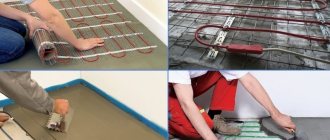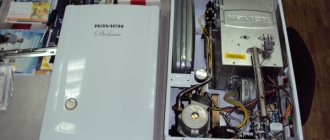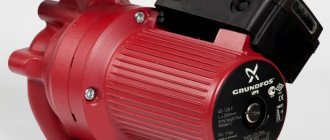It's nice to be the happy owner of numerous household appliance gadgets. Delivering many pleasant moments to their owner, they are undemanding and patient. But one day a moment comes when one of them suddenly stops reminding of himself. Here he was, and now he is no longer there. Even if it is an ordinary capacitive water heater, even a small one - 15 liters, the significance of the loss will be felt from the early morning. This feeling will not go away until the problem is completely resolved.
But there is always a solution. In this article we will look at the most common breakdown of Ariston water heaters associated with replacing the heating element.
- 2 Operating principle
- 3 Determine the malfunction
- 4 How to change
- 5 Check
How to remove and check the heater
Most often, heating elements in storage boilers break because they are constantly in the water. Regardless of the volume (50, 80 liters or more), the service life of the part can be influenced by various factors:
- Frequency of boiler use.
- Maximum heating temperature.
- Water quality.
Why do parts burn out? This happens when you turn on the equipment without water. Although most manufacturers prevent this point with the design features of the tank. Therefore, the main reasons for the heater to burn out will be water with a large amount of impurities and scale. The sediment covers the element in several layers, interfering with normal heat dissipation. As a result, the heating element overheats.
How to remove the heater with your own hands? First of all, unplug the boiler.
Make sure the warranty period has expired. If you open the tank while the warranty is valid, you will lose it.
Regardless of the brand (Polaris, Elenberg or Termex), turn off the machine in the control panel. Now start draining the water.
Draining the boiler
There are several ways to delete content. Via check valve:
- Place a deep container under the valve or connect a hose and lower it into the chamber.
- Open the valve and let the water drain out.
- With a tank volume of 30 liters, the procedure will last at least 1 hour.
With a volume of more than 80 liters, there is no point in waiting that long. Drain through the boiler inlet.
- Close the water inlet valve.
- Unscrew the cold water supply hose.
- Remove the valve.
- Unscrew the hose from the tank outlet.
- Open the boiler tap.
- Place the container and the contents will drain in a few minutes.
How to get heating element
Now it’s time to start dismantling the part; for this it is better to remove the equipment from the wall. The exception is models where the elements are located below. Proceed sequentially:
- First, disconnect all hoses that are connected to the housing. Be careful: water may spill out of them.
- Remove the body from the hooks and lower it to the floor.
- Remove the lid. Depending on the model, it may be positioned differently. It's better to look at the instructions.
- Remove the decorative washers from the pipes. They are found in Thermex heaters.
- Using a Phillips or slotted screwdriver, unscrew the screws or unfasten the latches.
- First, disconnect the thermostat wiring. Take a photo of it first to make the correct connection.
The green-yellow wire is responsible for grounding, the brown-black wire is the phase, and the blue wire is zero. Pull the thermostat down and out of the housing.
- To remove the heater, look at its mountings. Depending on this, select your tools.
To dismantle the element from Thermex and Oasis, you will need an adjustable wrench, since the fastening is a washer tightened with six bolts. In Elenberg, Polaris, Ariston, wrench No. 13 will help you unscrew the nut: remove the gasket and pull out the element. For Real - an adjustable wrench. Unscrew the edges and remove the part.
So, the heater is in your hands. Proceed with diagnostics.
Checking an element
The first stage is a visual inspection. Assess the general condition, the amount of scale and the integrity of the body. If the insulation is broken, only replacement will help.
To diagnose using a multimeter, you need to determine the resistance of the element of your model. To do this, look in the instructions for the power of the device. Then make calculations using this formula:
R=UхU/P. For example, power (P) is 1500 W. U is the voltage when connected. This means: R = 220x220/1500 = 32.3 Ohm.
Apply the multimeter probes to the heater contacts and see the result. If it matches the calculations, everything is fine. If 1-0 Ohm is displayed on the screen, a short circuit or break has occurred.
Next, the breakdown to the housing is calculated. The primary sign of such a breakdown is water that beats with electricity. A small discharge can be obtained by touching the tank.
Set the tester to buzzer mode. Place one probe on the contact of the part, the other on the body. Is the tester beeping? There was a breakdown.
For the next test you will need a megger. Set the range to 500 V. Connect the probes to the contact and body. Indicators of more than 0.5 Ohm are considered normal.
Perform diagnostics with a test light. Two wires with probes are adjacent to it. Apply the network neutral to one contact of the heater, and the phase through the lamp to the other. If it lights up, it means the part is working.
How to change the heating element? The new part must be selected in accordance with the model. The serial number can be found in the instruction manual. Installation is carried out in reverse order.
Installation and connection methods
“Dry” heating element
The heating element is a device that requires regular maintenance. After a while, it needs to be cleaned or replaced, depending on the efficiency and completeness of the work.
To clean the heating element yourself, you need to follow the instructions:
- Turn off the electric water heater.
- Disconnect the electric heater from the power supply.
- Open the protective panel by unscrewing the screws.
- Under the panel where the thermostat and colored wires are located, disconnect the cables.
- Shut off the water supply to the water supply and boiler.
- Pull out the thermostat along with the heating element, removing the flange if necessary. At the same time, place a container near the opening in case there is water in the tank. Unscrew the heating element using an adjustable wrench.
- Dissolve two packets of citric acid in two liters of water.
- Immerse the heating element in the resulting solution and leave for at least 12 hours. After some time, the heating element is ready for installation.
- Install in reverse order.
To check the correct installation of the heating element, you will need to turn on the water. If liquid leaks from the tank, the device is not connected correctly.
There are three main ways to connect a heating element for an Ariston water heater. Sequential - the heater power depends on the total power of each element. The disadvantage is that if one heating element breaks down, the functionality of the entire heating system is lost.
Parallel - allows you to maintain the functionality of the unit in the event of failure of one of the heating elements. Combined - usually used if heating elements of the required power are not available.
How to extend the life of the heater
There are several recommendations from experts:
- Entrust the installation to a professional or follow the instructions exactly.
- Before turning on, do not forget to fill the tank with water. You cannot turn on the boiler with an empty tank.
- Replace the magnesium anode in a timely manner. It “softens” the water, preventing scale from settling on the parts.
- It is advisable to install cleaning filters on the hoses. This will extend the life of the anode and heating element.
- At least once a year, inspect the internal elements and check their condition.
- Do not set the thermostat to maximum values. This forces the heating element to work at its limit. It also turns on more often to maintain temperature.
You can repair the boiler yourself, the main thing is to adhere to safety precautions. If the equipment is under warranty, contact the service center, do not open the tank.
A video on the topic will help you carry out the check correctly:
The most vulnerable parts
Today, Ariston is the top three world leader in the production of equipment. The kitchens of this company are equipped with a range of household appliances - from a refrigerator to a dishwasher. In Russia, the brand gained popularity in the late nineties; its service centers can be found in all major cities.
In this video you will learn how to drain water from a water heater:
The peculiarity of electric boilers is their modern design, functionality and affordable price compared to analogues. The developers place special emphasis on the safety of their products during operation: the devices are equipped with various protections that turn off the device in the event of power surges, overheating, or lack of water supply.
Despite their reliability, water heaters are vulnerable to hard water and power failures . According to experienced experts, the weak points of Ariston water heating devices are tubular elements, magnesium anode and check valve. You can fix these simple faults yourself with a minimal set of tools. The products are characterized by a standard assembly scheme, so repair and maintenance work is not particularly difficult.
The owner must monitor the integrity of the internal coating of the tank, the processing of which uses modern materials containing glass ceramics, titanium, strengthening enamels, silver, and other high-tech additives.
Prevention as a way to avoid problems
Not only home owners provide themselves with autonomous hot water. More and more residents of apartment buildings prefer to install instantaneous or storage water heaters. There are 2 reasons for this unconditional popularity: interruptions in hot water supply, especially in the off-season, and the high cost of hot water supply.
Italian Ariston boilers have been popular for several years now. They are distinguished by high quality, reliability, and long service life if used correctly. Nothing lasting has been invented yet, and therefore sometimes you have to do repairs yourself.
And although a water heater is a rather complex device, its regular cleaning and maintenance can be done independently in just a couple of hours. The main thing is that before you start the actual work, understand not only how the equipment works, but also how to disassemble it correctly.
The most important thing is to completely drain the water from the boiler. There are 2 pipes installed on the lower part, through one of them water flows into the boiler, through the second it is drained.
Even after the water has completely drained, some of it remains at the bottom of the tank, so before opening the lid, place a bowl to catch the remainder.
Since high-quality drainage is the key to a successful outcome of the entire operation, we will dwell on it in more detail.
The procedure depends on the features of the particular model - with a trigger, a tee or through a check valve.
- The most demanding model is considered to be the one in which a reinforcing tee is built between the pipe and the valve. You will have to unscrew it with an adjustable wrench and drain all the water.
- on those models where there is no tee, but there is a trigger - a jumper on the reverse valve. You can bend it, fix it and wait until all the water drains. This process usually takes 1.5-2 hours.
- The simplest and therefore most effective way is to unscrew the check valve counterclockwise. Before doing this, connect the hose to the water outlet pipe and drain.
If, during any manipulation, water does not flow from the return, open the hot water tap to create the necessary air flow, and do not close it until the boiler is empty.
Attention! All work is carried out only after the water heater is disconnected from the power supply!
Filling with water and checking functionality
Hang the electric titanium in place.
Connect the hoses and open the cold water and begin to fill the tank. The hot water tap must also be open to allow air to escape. At the same time, make sure that there are no leaks anywhere. As soon as water comes out of the “hot” tap, the boiler is full. There is no need to close the tap immediately; let all the “slurry” spill out and finally flush the tank and pipes.
Only when clean water comes out do you turn off the mixer.
After this, the water heater must stand for at least half an hour or an hour so that condensation leaves all surfaces and there is confidence that there are no leaks.
You can then apply voltage by plugging the titanium into an outlet. To check the operation of the thermostat, use the control knob to force the adjustment to maximum and minimum.
In this case, the boiler on/off light should light up.
If the boiler operates quietly, without making any sounds, and it is not clear to you whether it is heating or not, you can check the energy consumption using the meter.
At maximum heating power of the heater, the counter will spin or blink much faster. This means that the heating elements work as they should. The entire repair with the purchase of spare parts will cost you around 1500-2000 rubles. In any workshop that calls a plumber to your home, they will ask for at least 3,000-5,000 rubles for such work, and this does not include materials.
So self-repair can save you a significant amount of money, the main thing is not to make some mistakes.
How to replace the heating element in an Ariston boiler yourself?
The heater in the Ariston boiler suddenly broke; the family cannot live without warm water. How to replace the heating element in a boiler yourself?
Failure of the heating element is a fairly common problem with water heaters, therefore, in order to extend the life of the water heater, it is recommended to clean it once every six months to a year. If this is done with such frequency, then the service life of the water heater and heating element can be significantly extended and you can be confident in its performance, because a heating element covered with a thick layer of scale not only fails faster, but also heats water worse, which makes life not so comfortable.
Replacing heating elements in different models of water heaters may differ. Often people buy water heaters without an electronic display, so I will talk about replacing the heating element in such a model (the process will be approximately the same for this type of water heaters). I should immediately note that the view inside the water heater will not be the most pleasant; there is a lot of scale, especially if the water heater has not been cleaned for more than a year. I advise you to completely disconnect the water heater, remove it and lay it horizontally on a flat surface. So, we pry up and remove the cover under which the temperature regulator and the heating element itself are located. Most likely, there are two wires connected to the cover; you can immediately disconnect these two terminals, just first remember what is attached where. In general, I advise that when you disconnect something, make notes with a marker or take photographs, so that you don’t have to guess later how to connect it back. Now unscrew the wires from the thermostat. I also advise you to remember what level the temperature regulator is set to.
Now our task is to pull out the heating element itself. To do this, you need to unscrew the nuts or other fasteners. Once this is done, the element can be retrieved. Actually, as you can see, there is nothing particularly complicated about this. Now the heating element must either be replaced or cleaned if you carry out maintenance work. It is advisable to clean the heating element with a wooden stick. The water heater tank itself also needs cleaning. I recommend buying one or two bottles of Coca-Cola and letting the scale settle. You can also soak the heating element. This drink is still disgusting, it removes scale well, then, accordingly, it is necessary to thoroughly rinse this drink from the walls of the tank and from the heating element itself.
After all the work is completed, we put the water heater in place and check it for leaks; you need to be extremely careful, since there are wires running nearby.
To replace an electric heating element in a boiler, naturally, you need to completely de-energize it and remove the wires from the current-carrying blocks by unscrewing the clamps.
Next, pull out the control system assembly by simply pulling it down by the ceramic cup, it will remove the contacts of the electric heating element, and the thermocouple will come out of the tube soldered into the tank - put it aside so as not to damage it.
Next, open the taps and drain as much water as possible, place a container (something like a wide basin) and begin to unscrew the bolts securing the hatch of the tank in which the electric heating element is installed.
Then pull out the hatch along with the heating element and unscrew the heating element, replacing it with a new one.
If you didn’t know what kind of heating element is in the boiler, then take the burnt one as a sample to buy a similar one. It would also not hurt to clean and rinse the tank from dirt and sediment before assembly, possibly even scale, depending on how long the boiler has been in operation.
Everything is assembled in the reverse order, first the heating element is screwed to the hatch, then the hatch is screwed to the tank and then the control system is inserted into it, the tightness is checked for leaks and then the wires are connected to the terminals of the control system.
Yes, indeed, the process of replacing heating elements on storage-type water heaters has some features that are unique only to models of this company.
Before starting work on changing the heating element, first of all, you need to turn off the power to the equipment. Turn off the circuit breaker and unplug the power plug from the outlet. Turn off the cold water supply valve to the water heater. Unscrew the hot water outlet hose from the water heater (marked in red on the water heater), but preferably not at the point of attachment to the boiler (the same as the “water heater”), but for a longer time so that you can lower it directly into the sink or toilet to flush. Now unscrew the cold water supply hose on the boiler itself (it is marked in blue). Drain the water in the water heater into the sink or toilet)
Replacing a heating element in an Ariston water heater: overview of the device and how to do it yourself
It's nice to be the happy owner of numerous household appliance gadgets.
Delivering many pleasant moments to their owner, they are undemanding and patient. But one day a moment comes when one of them suddenly stops reminding of himself. Here he was, and now he is no longer there. Even if it is an ordinary capacitive water heater, even a small one - 15 liters, the significance of the loss will be felt from the early morning. This feeling will not go away until the problem is completely resolved.
But there is always a solution. In this article we will look at the most common breakdown of Ariston water heaters associated with replacing the heating element.
What types of heating elements are there for heating water with an Ariston thermostat?
In most cases, Ariston heating elements are copper, but there are also stainless steel designs. They can be different in shape, depending on the design features. If the tank is vertical, you need a straight heating element. And curved models are needed for horizontal boilers.
What does the design of the Ariston heating element look like:
- Directly the heating element itself;
- Tubes for temperature sensor;
- A special hole for the heating element is a flange;
- There are places for the anode, however, not all models have them on the flange.
Ariston heating elements are mostly called wet. This means that the heating elements are in contact with water. True, there are also closed-type models; they are built into the flask and do not come into contact with water. This heater is accordingly called dry.
Design
Ariston water heater design.
(Click to enlarge) Fundamentally, the design of any water heater (boiler) resembles the design of an electric kettle with the function of maintaining a given temperature. But instead of a lid, this kettle has a safety valve.
Depending on the brand, its copyright holder includes a variety of marketing and technical options in the design. Such options are designed to distinguish the product of this particular brand from another.
The hallmark of Ariston storage water heaters is, among other things, the corrosion-resistant coating of the internal tank containing Ar+ silver ions.
This does not exclude the use of other protective coatings in other products of the company. The Ariston AM50 SH 2.0 Ei3 FE model (horizontal model) uses Ti-enamel as a protective coating.
Structurally, such a device consists of:
- external, heat-insulated housing (tank);
- internal tank with a volume of 15 liters to 200 liters with a corrosion-resistant coating or made of stainless steel;
- Heating element – heating element: in a tank with a wet heating element – direct contact with water;
- with a dry heating element – contact with water through a ceramic shell;
Troubleshooting instructions
Ariston boiler repair consists of a series of actions that must be performed sequentially. First of all, before carrying out manipulations, it is necessary to determine the specific problem. For example, if you need to replace a safety valve, thermostat or relay, there is no need to dismantle the device. It is necessary to disassemble the device and drain the water during maintenance or replacement of a burnt heating element. Disassembly is carried out in several stages:
- First you need to disconnect the product from the network;
- drain the water;
- dismantle the flanges to get to the inside.
These are standard manipulations that should not be neglected. There have been numerous cases when home craftsmen, having forgotten to disconnect the device from the power supply, received electric shocks of varying severity. Having de-energized the device, you can begin dismantling it:
- Unscrew the cover secured with screws.
- Take photographs of the location of the wires and bolts so that nothing gets mixed up during assembly.
- Carefully disconnect the three-core cable. The first two wires - phase and zero - are connected to the thermostat. Then the latter must be carefully removed.
- Then you can start draining the liquid.
Principle of operation
The operating principle of a storage water heater.
(Click to enlarge) Structurally, the boiler is two barrels isolated from each other.
One of them (internal) is made of either stainless steel or high-quality steel with an anti-corrosion coating.
Modern heat-insulating materials are used as insulators.
This can be basalt fiber, polyurethane foam and similar insulators. Such a “thermos” can retain the heat of heated water for up to 3 days.
To avoid mixing cold and already heated water, the latter is taken from the very top of the device. Cold water, displacing hot water, is always at the bottom.
When using equipment wisely, you should not force it to constantly work at maximum load. Every technology has its own resource.
Determining the malfunction
The reliability and quality of water heaters produced under the Ariston brand have not raised the slightest doubt for many years.
It is enough just to follow the technical recommendations for operation prescribed by the manufacturer. But the notorious human factor makes its own adjustments here too. One day the boiler stops working normally - it stops heating the water or does it very slowly.
Most often, the reason for this is problems associated with the electrical part of the device:
- broken switches;
- fuses, various sensors;
- heating units.
But before you start diagnosing and repairing them, you just need to check:
- availability of electricity in the supply network;
- availability of water supply sources;
- make sure that there are no consequences from children's pranks: closed ball valves;
- pulled plugs from electrical sockets;
- Are there any problems with the thermostat?
When all of the above has been checked and the listed reasons are excluded from the list of possible causes, we check the functional state of the heater itself:
- a decrease in its effectiveness due to scale formed;
- short circuit as a result of leakage;
- due to burnout of the spiral itself.
This procedure is most conveniently performed using a tester, by measuring the resistance of the product being tested. The technical data sheet of the boiler indicates the power of the installed heating element. Using the formula P = U2/R, Ohm's law, we determine its resistance.
For a heating element with a power of 2 kW, the resistance is about 27 Ohms. You should also check the possibility of breakdown of the spiral on the body of the water heater.
You may be interested in an article about installing an Ariston gas water heater.
Read an article about the features of repairing an Ariston water heater with your own hands here.
How to change
Whether a malfunction of the heating element has been identified or a decrease in the efficiency of the device is due to the formation of scale, it will have to be dismantled.
It is possible that the heating element will be replaced simultaneously with preventive cleaning of the internal tank. First of all, you need to:
- disconnect the device from the power supply;
- remove the outer protective cover from the assembly;
- check the absence of voltage at the thermostat terminals with a phase meter probe (indicating screwdriver) and free them from the wires, having previously photographed the connection order;
- remove the thermostat with thermostat;
- close the ball valve at the water inlet, remove the check valve;
- remove water from the water heater through a hose from the valve or directly through its own drain system;
- Unscrew the nut securing the heating element to the mounting plate;
- squeeze the heating element with the rubber sealing flange and anode into the tank;
- unfold it inside the tank and pull it out;
- descale the tank and rinse it;
- If the heating element is in good working order, replace the anode and clean the heating element from scale;
- if the heating element is faulty, replace it with a new one recommended by the manufacturer;
- replace the anode with a new one;
- assemble everything in reverse order, using previously taken photographs of connecting the wires to the thermostat.
You may also be interested in an article about Termex storage water heaters.
Read the article on how to change the heating element in a Termex water heater here.
Installation and connection of the boiler to the network
Under no circumstances should the ground wire be connected to the neutral wire.
The device comes with a standard cord and plug for connecting to the mains. In normal condition, when the Termex is hanging correctly, the intake tube hole inside the tank enters in the upper quarter, and the inlet pipe in the lower quarter.
To correct this drawback, you need to remove them and give them the desired shape, and also slightly bore the holes for the bolts.
Installing a boiler The first step is to fix the heater on a load-bearing wall, taking into account the fairly large weight of the equipment. Such devices do not require special installation, as they operate from a regular outlet. The device cannot withstand thermal conditions.
What affects the heating temperature of water? This design feature allows you to change the lateral tilt of the case by simply moving the bottom point of the drive. But this is only provided that the water in the system meets the necessary standards and does not contain a large amount of impurities and heavy elements, and that the installation, operation and timely maintenance rules are followed when using the device. Electrical diagram for connecting a water heater through a socket connected to a cable laid from the switchboard: The difavtomat can perfectly replace a combination of an RCD and a circuit breaker.
Unscrew the drain valve5. Also, the operating instructions for the equipment must include an electrical diagram of the water heater and a network connection diagram. Installing a boiler The first step is to fix the heater on a load-bearing wall, taking into account the fairly large weight of the equipment. Most often, the design of a water heater has two thermostats: the first controls the heating of water, and the second monitors the condition of the first.
If necessary, replace it with a fresh one. Failure to carry out cleaning work will lead to a decrease in operating efficiency and a decrease in the level of efficiency. Note that the manufacturer has established a minimum service life of a Termex water heater of seven years.
It is capable of being shaped and is not afraid of temperature changes. If the brackets are held for some time, the characteristic will change quickly. The valve is often included with the water heater, but it can also be purchased separately. Experts say that using a regular check valve is highly undesirable. When installing these elements with your own hands, turn the thread no more than once, otherwise you will damage the pipe. Connection diagram of the boiler to the water supply
Heating element for Ariston water heater: types and their characteristics
Ariston brand water heating equipment is of high quality. But even its individual parts can break under harsh operating conditions. Therefore, it is extremely important to take into account the basic nuances of handling such equipment.
Peculiarities
Today it is impossible to imagine a comfortable apartment or even a private house without hot water. Where it is not possible to use central heating, you have to install water heaters. If such a system is chosen correctly and installed properly, it will provide the household needs of a large family quite effectively. The decisive link in the heating equipment is the heating element, which is a copper or stainless steel element. Its tube contains a spiral inside, through which a strong current passes.
The heater for an Ariston and any other boiler differs from those similar devices that are mounted in electric kettles or in washing machines and dishwashers. Its total electrical power is noticeably greater, because it is necessary to heat a significant amount of liquid in a short time. The company produces both “wet”, made in an open circuit, and “dry”, hermetically sealed heating elements. Ariston Corporation uses an alloy of copper with chromium and nickel to make its heaters.
A specially designed brass flange allows the maximum amount of thermal energy to be released.
Power varies depending on the specific model. All the highest quality heating elements are equipped with a thermostat. This block stops the operation of the device as soon as its temperature becomes critical. On the other hand, the automatic system gives a command to start even when the temperature drops below a certain threshold. Therefore, when buying Ariston products, you don’t have to worry that any negative phenomena will arise or there will be a risk of fire.
Types and device
- An Ariston 100-liter water heater can be represented, for example, by the Abs Pro R 100V . This model requires heaters capable of raising the water temperature to 75 degrees and capable of being under liquid pressure from 0.2 to 7 atmospheres. Heating is controlled mechanically; the indicator only shows on and off. There is a thermometer in the system, as well as a heating degree limiter. The protective anode is made of magnesium.
- The 80L wall heater is the Abs Blu R 80 V Slim . The device must provide direct heating with a power of 1.5 kW. The control is organized mechanically, the highest temperature created is 75 degrees. The wet type device is equipped with impeccable automatic shutdown. The developers have provided for active prevention of corrosion due to a large magnesium anode.
- For the Abs Vls Evo Inox PW 50 with a capacity of 50 l, the use of two heating elements is provided at once - one for 1000, the other for 1500 W. Modern design allows to reduce energy consumption by 12 -16%. At the same time, the operating speed is very high compared to similar models.
- Abs Blu Evo RS 30 , as the name suggests, is designed to heat 30 liters of water. The total power is 1500 W; accelerated heating is not provided by the designers.
Water heats up to 60 degrees in 70 minutes. The only wet heater must operate at a voltage of 220 V with a water pressure of up to 8 bar. The 200-liter gas boiler of the Marco Polo Gi7S 11L FFI type is a worthy competitor to the above-mentioned electric devices. Here are its main parameters:
- total power 22 kW;
- water heating 75 degrees;
- fluid pressure from 0.6 to 8 bar;
- the amount of moisture heated per minute is up to 11 liters.
It is noteworthy that this model clearly illustrates the impressive capabilities that other – already electric – devices from the Italian manufacturer, belonging to the high price class, have. Reliable protection against overheating and automatic diagnosis of problems in the device are provided. The system is able to regulate its power smoothly, change the intensity of water passage and its temperature. A programmed amount of water can be dispensed. Open heating elements, including those installed in tanks with a capacity of 15 liters, can heat water faster and are relatively inexpensive.
But they have a serious problem - increased current consumption, insufficient safety and short operation.
Anyone who wants to get a reliable and economical product purchases a dry type heater. True, there is no hope for prompt heating of the liquid with such equipment. For a small tank capacity this does not play a special role, since it is difficult to notice the difference. In addition to the magnesium anode, limiting the temperature with a thermostat also contributes to preserving the heater for a long time (the higher it is, the more active the corrosion).
In dry heating elements designed for both 1000 W and any other power, there is no boundary between the casing and the flange. The internal surfaces are invariably coated with protective enamel. Engineers take this step to further reduce the intensity of rusting. In both wet and dry circuits, a magnesium anode is used, which “draws” the oxygen released from the water. Therefore, it will not be able to react with the steel parts of the body and the heater itself, and therefore the corrosion process will be slowed down.
You should not rely on enamel alone, because a constant temperature change leads to its cracking.
The anode is placed in close proximity to the heating element, and therefore they need to be considered in conjunction. Returning to the main topic, it is worth pointing out that any exemplary rating table includes Velis heating parts. For this model, a wet format heating element is used with a flange with a diameter of 12.5 cm, in which 5 holes are made. The voltage is standard, you won’t be able to use two blocks at once, the type of connection is pin, contact M5.
How to choose the right mechanism
Heating element for Ariston boiler
How is the designation of the heating element read, for example, heating element - 32 A 13 / 1.5 J 220 where:
- TEN – tubular electric heater.
- 32 – expanded length of the heating element along the shell.
- A – designation for sealing the contact rod.
- 13 – diameter of the heating element shell.
- 1.5 – rated power in kW.
- J – designation of the heating medium and heating element material
- 220 – rated voltage in V.
If you follow the markings, you can find the right model quickly and without unnecessary nerves. And for this you don’t need to walk around with a centimeter or carry a broken product with you. It will be enough to compare the data on your heating element and the one you are going to buy.
When choosing a heating element for an Ariston boiler, you should pay attention not only to the price, but also to the design differences. It is also necessary to take into account the operational characteristics of electric heaters
Having a stable voltage and proper operating conditions, a “wet” heating element will last on average 5 years, and a “dry” one – 15.
The company recommends purchasing equipment for replacement in factory-made water heaters and according to the existing model of the unit.
Heating elements with a power of 1.5 kW are more common for Ariston boilers. They are often used in equipment with a volume of both 20 liters and 100.
Engineers categorically do not advise replacing a low-power heating element with a more productive one, since the water in the equipment heats up to 85 degrees and the boiler turns off. And high power disrupts the operation of the device and increases the cost of each water heating.
When choosing a heating element, you should also pay attention to the flange. Threaded - thanks to the existing thread, the heater is attached to the boiler by screwing
The thread diameter is 1 1/4 inches. Clamping ones - come in the following diameters: 62 mm, 72 and 82 mm.
For dry heating elements - they are made of enameled metal, almost always in pairs, and have closely spaced contacts with a “petal” type fastening.
How to replace?
If the heater in the system attached to the wall fails, it will be quite possible to get it out even on your own. In systems that are not equipped with an electronic display, you need to be prepared for a very bad view inside the device. It is recommended to remove the entire water heater from its mounting and place it on a flat, horizontal surface. The lid is lifted, this is enough to open the system.
Disconnecting the terminals can be done immediately, the main thing is not to forget what they were connected to. Marker notes or even a photograph can help here. By disconnecting the wires connected to the thermostat, you can remove the heating element directly. To do this, remove the fasteners that hold it in place. This procedure is performed not only during replacement, but also during repair, maintenance or troubleshooting.
Of course, in order to change the heater, the device must first be de-energized. Having finished the work, they put the new block in place and carefully assess whether there are any water leaks. Since there is wiring nearby, great care will have to be taken. During work, it is recommended to put the removed thermocouple away so as not to break it.
Attention: without knowing for sure which heating element is installed in the heater, it is better to take a damaged sample to the store before purchasing.
Installation and connection methods
“Dry” heating element
A heating element is a device that requires regular maintenance. After a while, it needs to be cleaned or replaced, depending on the efficiency and completeness of the work.
To clean the heating element yourself, you need to follow the instructions:
- Turn off the electric water heater.
- Disconnect the electric heater from the power supply.
- Open the protective panel by unscrewing the screws.
- Under the panel where the thermostat and colored wires are located, disconnect the cables.
- Shut off the water supply to the water supply and boiler.
- Pull out the thermostat along with the heating element, removing the flange if necessary. At the same time, place a container near the opening in case there is water in the tank. Unscrew the heating element using an adjustable wrench.
- Dissolve two packets of citric acid in two liters of water.
- Immerse the heating element in the resulting solution and leave for at least 12 hours. After some time, the heating element is ready for installation.
- Install in reverse order.
To check the correct installation of the heating element, you will need to turn on the water. If liquid leaks from the tank, the device is not connected correctly.
There are three main ways to connect a heating element for an Ariston water heater. Sequential - the heater power depends on the total power of each element. The disadvantage is that if one heating element breaks down, the functionality of the entire heating system is lost.
Parallel - allows you to maintain the functionality of the unit in the event of failure of one of the heating elements. Combined - usually used if heating elements of the required power are not available.
Tips and tricks
Before replacing the heating element in the water heater, be sure to drain all the water from the tank. The only way to check whether this part is really broken or whether the boiler is not working for another reason is with a multimeter. The RCD must be rated at 10 mA; if this requirement is not met, you may encounter current penetration into the most unpredictable places. In some models, you have to remove the cold and hot water valves to access the electric heater; More detailed information is provided in the technical documentation.
Dry parts are more compact and can be placed in boilers in whole pairs; This solution increases the stability of the equipment.
To learn how to choose a water heater, watch the following video.
Filling with water and checking functionality
Hang the electric titanium in place.
Connect the hoses and open the cold water and begin to fill the tank. The hot water tap must also be open to allow air to escape. At the same time, make sure that there are no leaks anywhere. As soon as water comes out of the “hot” tap, the boiler is full. There is no need to close the tap immediately; let all the “slurry” spill out and finally flush the tank and pipes.
Only when clean water comes out do you turn off the mixer.
After this, the water heater must stand for at least half an hour or an hour so that condensation leaves all surfaces and there is confidence that there are no leaks.
You can then apply voltage by plugging the titanium into an outlet. To check the operation of the thermostat, use the control knob to force the adjustment to maximum and minimum.
In this case, the boiler on/off light should light up.
If the boiler operates quietly, without making any sounds, and it is not clear to you whether it is heating or not, you can check the energy consumption using the meter.
At maximum heating power of the heater, the counter will spin or blink much faster. This means that the heating elements work as they should.
So self-repair can save you a significant amount of money, the main thing is not to make some mistakes.











